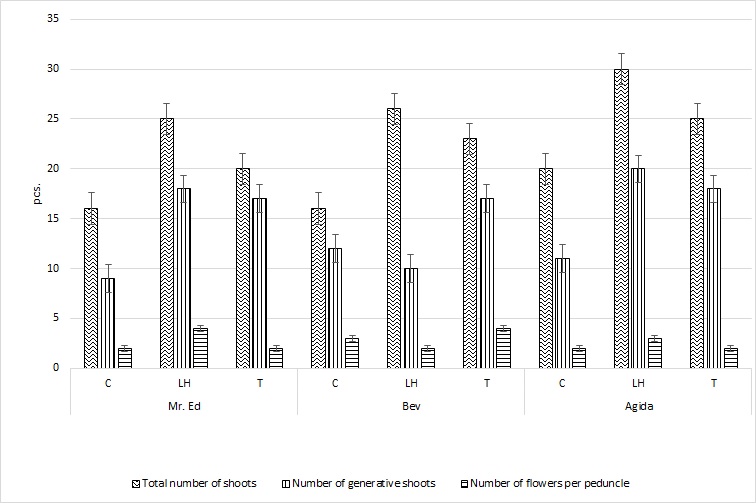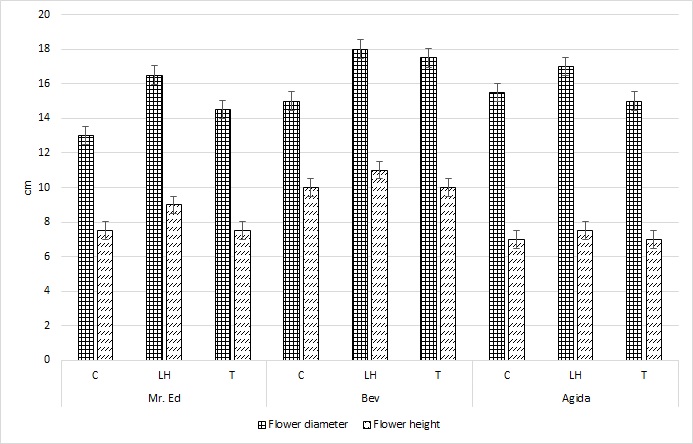EFFICIENCY OF USE OF THE GROWTH-REGULATING PREPARATIONS ON THE BIOLOGICAL CHARACTERISTICS OF PEONIES
EFFICIENCY OF USE OF THE GROWTH-REGULATING PREPARATIONS ON THE BIOLOGICAL CHARACTERISTICS OF PEONIES
Abstract
The article reflects the results of studying the effectiveness of the action of the specialized preparations «Lignohumate» and «Trainer» on the growth, development and decorative qualities of some representatives of the Paeonia L. genus complex in the conditions of the Bashkir Cis-Ural. It is shown that under the influence of the studied preparations there was an increase in the number of shoots and flowers on one peduncle, as well as a change in the diameter and height of the flower. It was noted that the use of growth regulators significantly affected the following decorative features: the size of the flower, the abundance of flowering and the number of buds on the peduncle. Among the economic and biological parameters, a large difference between the control and the experiment was noted for the traits: productivity and duration of flowering, reproductive ability and resistance to diseases and pests. Thus, the studied plant growth regulators can be recommended for use in floriculture, as they increase the decorative effect of cultivars.
1. Introduction
An obligatory part of modern technologies used in crop production is the use of plant growth regulators, which allows accelerating the growth and development of the latter, increasing crop yields and product quality, plant resistance to diseases and adverse environmental conditions, and improving the survival rate of seedlings and seedlings , .
The use of anti-stress preparations of both synthetic and natural origin is an important reserve for increasing plant resistance to adverse growing conditions . Currently, preparations of natural origin, called humic fertilizers, are gaining wide popularity . They have a wide range of applications, are highly efficient and environmentally friendly. Humic substances play one of the most important roles in improving the physical and chemical properties of the soil, activating the microflora, and migration of nutrients .
Previously, the growth-stimulating, rhizogenic and antifungal effects of known plant growth regulators on agricultural and ornamental crops, such as chrysanthemums , irises , lavenders , violas , asters were repeatedly shown.
The aim of the study was to assess the influence of modern plant growth regulators on the growth, development and change in the decorative and economic-biological qualities of some varieties of Paeonia lactiflora.
2. Research methods and principles
The studies were carried out in 2020-2022 in the open field on the basis of the South-Ural Botanical Garden-Institute of Ufa Federal Research Center of the Russian Academy of Sciences (hereinafter referred to as the SUBGI UFRC RAS) on a collection of varietal peonies. The objects of study are varieties of Paeonia lactiflora Pall. (‘Agida’, ‘Bev’, ‘Mr. Ed’), introduced to the territory of the SUBGI UFRC RAS in 2015.
The experiment scheme included the following options:
1. Lignohumate (0.3%); 2. Trainer (0.3%); 3. Control.
Foliar treatment of cultivars was carried out (1.5−5 l/ha or 0.15−0.3% solution) 3 times during the season in the phases of regrowth, budding and flowering. Consumption 5 g/10 l of water. The use of a working solution in the amount of 200−300 l/ha. Control variants were sprayed with clean water.
Lignohumate is a natural growth stimulator and antistress agent. A complex of humic and fulvic acids, enriched with trace elements in chelate form. Stimulates the growth and development of the root system, as well as the plant as a whole, relieves stress during pesticide treatment, increases frost resistance and drought resistance, increases yield and product quality, increases the intensity of leaf color and flower color .
Trainer is a biostimulant to prevent the consequences of any abiotic stresses and to comprehensively support plant development in the most important growth phases. Features of the drug: high concentration of plant amino acids and peptides; optimal supply of organic matter; elimination of the risk of manifestation of phytotoxicity of pesticides; increasing tolerance to all abiotic stresses; increase in the quantity and quality of the crop .
The studies were carried out in accordance with the method of variety testing and the method of state testing of growth regulators . During the period of mass flowering of plants, measurements were carried out according to 21 indicators (bush height, peduncle height and thickness, total number of shoots, number of generative shoots, sheet length and width, length and width of a leaf share, petiole length, flower diameter and height, length of the outer petal, outer petal width, inner petal length and width, number of flowers on the peduncle, pestle length and width, number of pestles, filament length). The counts were carried out in six repetitions. In each variant, there were ten accounting plants.
Decorative and economic-biological assessment was carried out on a five-point scale based on the methodology of V.N. Bylova . For evaluation, biometric and visual studies were carried out, after which points were set from 1 to 5, taking into account the conversion factor.
Mathematical processing of the experimental data was carried out by standard methods using the statistical packages of the Microsoft Excel 2003 program and the AgCStat add-on.
3. Main results
As a result of the experiments, it was revealed that the tested preparations influenced the controlled parameters of plants. The use of growth regulators had a positive effect on the height of the bush and peduncle in all varieties and increased these figures by 1.2−1.3 times compared with the control (Fig. 1).
An important indicator characterizing the decorativeness of flowering plants is the number of shoots, including generative ones, and the number of flowers on one peduncle. The total number of shoots was subject to change and increased, compared with the control, by 1.2−7.8 times. The number of generative shoots, as well as the number of flowers on the peduncle, also varied and increased by 1.3−2 times (Fig. 2).

Figure 1 - Influence of growth regulators on the height of the bush and peduncle of peony varieties:
C − control; LH − Lignohumate; T – Trainer

Figure 2 - Influence of growth regulators on the number of shoots and flowers of peony varieties:
C − control; LH − Lignohumate; T – Trainer

Figure 3 - Influence of growth regulators on the diameter and height of the flower of peony varieties:
C − control; LH − Lignohumate; T – Trainer
It was noted that the drug “Lignohumate” had an impact on a greater number of signs than “Trainer”. The most susceptible object of study was ‘Agida’, the least susceptible was ‘Bev’.
The decorativeness of peony varieties is determined by the main features: the size, color and doubleness of the flower, the abundance of flowering and the number of buds on one peduncle. Among the economic and biological characteristics, the following were distinguished: the duration and productivity of flowering, reproductive ability and resistance to diseases and pests, as well as to adverse conditions.
It was noted that the use of growth regulators significantly affected the following decorative features: the size of the flower, the abundance of flowering and the number of buds on the peduncle (Table 1). The color and doubleness of the flower did not change in any way when using drugs.
Table 1 - Comprehensive assessment of peony varieties
Index | Experience options | ||||||||
‘Agida’ | ‘Bev’ | ‘Mr. Ed’ | |||||||
C | LH | Т | C | LH | Т | C | LH | Т | |
Decorative signs | |||||||||
The number of buds on the peduncle | 8 | 10 | 8 | 8 | 6 | 10 | 8 | 10 | 8 |
Abundance of flowering | 9 | 15 | 12 | 12 | 9 | 15 | 12 | 15 | 12 |
Flower size | 12 | 15 | 9 | 9 | 15 | 12 | 9 | 15 | 12 |
Flower coloring | 5 | 5 | 5 | 5 | 5 | 5 | 5 | 5 | 5 |
Terry flower | 5 | 5 | 5 | 5 | 5 | 5 | 5 | 5 | 5 |
Total | 39 | 50 | 39 | 39 | 40 | 47 | 39 | 50 | 42 |
Economic and biological features | |||||||||
Flowering productivity | 9 | 12 | 15 | 15 | 9 | 15 | 9 | 12 | 15 |
Flowering time | 8 | 10 | 10 | 8 | 10 | 10 | 8 | 10 | 10 |
Reproductive ability | 9 | 15 | 12 | 9 | 15 | 12 | 9 | 15 | 12 |
Disease and pest resistance | 4 | 5 | 5 | 4 | 5 | 5 | 4 | 5 | 5 |
Resistant to adverse conditions | 5 | 5 | 5 | 5 | 5 | 5 | 5 | 5 | 5 |
Total | 35 | 47 | 47 | 41 | 44 | 47 | 35 | 47 | 47 |
Comprehensive assessment | 74 | 97 | 86 | 80 | 84 | 94 | 74 | 97 | 89 |
Note: C − control; LH − Lignohumate; T − Trainer
Among the economic and biological traits, a large difference between the control and the experiment was noted for the traits: productivity and duration of flowering, reproductive ability and resistance to diseases and pests (Table 1).
A comprehensive assessment showed that the use of plant growth regulators “Lignohumate” and “Trainer” had a positive effect on the considered characteristics of the objects of study. Peony varieties "Agida" and "Mr. Ed" received the maximum score when using these drugs.
4. Conclusion
Thus, the use of plant growth regulators “Lignohumate” and “Trainer” on some varieties of Paeonia lactiflora accelerated their growth and development, and also contributed to an increase in their decorative effect.
It is shown that under the influence of the studied preparations there was an increase in the number of shoots and flowers on one peduncle, as well as a change in the diameter and height of the flower.
When analyzing the decorative and economic and biological characteristics of the varieties of Paeonia lactiflora, it was noted that the treatment with growth regulators had a positive effect on the main indicators and a comprehensive assessment of the objects of study differed significantly from the control options.
Thus, the studied plant growth regulators can be recommended for use in floriculture as a factor that increases the decorative effect of cultivars.
